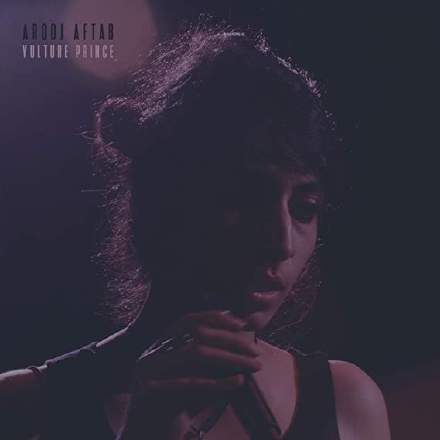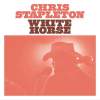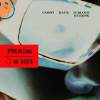
It was this year’s Grammy nominations that alerted me to Arooj Aftab, as she’s up for Best New Artist and also has this song in the running for Best Global Music Performance. I’ll admit that it’s hard to imagine anyone but Olivia Rodrigo walking away with the former category, but I can’t imagine a more worthy winner for the latter than this star turn from Aftab. That the lush backing texture is so understated only makes her achievement more impressive, because it means she’s pretty much responsible for carrying the production on her own.
Now, she apparently disdains stylistic labels, so maybe it’s not surprising that the backing instrumentation doesn’t shout any obvious genre label. I mean, if I had a penny for every artist who’s decided to pad out their album by noodling reverberantly on an acoustic-guitar pedal-note riff for upwards of seven minutes, I’d probably have about £287.43, and those records would cover a pretty wide stylistic spectrum. Ask youself, for instance, whether after the first four bars of this music you’d have been at all surprised if a Gaelic folk vocalist had appeared instead. Or a couple of plaintively harmonising bluegrass singers. Or a contemplative Eddie Vedder.
What does, however, transmit extremely strong genre cues to us Westerners is Aftab’s evocative Hindustani vocal stylings (see Further Note below) – enough, indeed, for the Grammy committee to put this eclectic Berklee College graduate in their ‘World’ category, despite her having been active in various areas of the New York music scene for more than a decade. And, if you’re anything as uneducated about non-Western music as me, then the Urdu text, the sinuous vocal flourishes, and the music’s fluid structure might all feel a bit intimidating at first, to be honest, simply because they’re so different from most of what I normally hear day to day. So with this in mind, let me see if I can point out some of the musical features that have helped me deepen my appreciation for this production’s many qualities.
The lyrics are apparently taken from a famous Urdu love poem written about a century ago by Hafeez Hoshiarpuri, and Aftab herself has provided a rough translation of it for the benefit of linguistic minnows like me. Here’s a transliteration of the Urdu with the English below it:
Mohabbat karne vaale kam na honge
Teri mahafil men lekin ham na honge
Seeing how you have ample lovers around you,
I will not be one of those lovers to you.Zamaane bhar ke gham ya ik tera gham
Ye gham hoga to kitane gham na honge
Teri mahafil men lekin ham na honge
This is sad, as I love you the most, the sadness of this is equal to the sadness of all the world.
And were there not this one sadness, how much happiness there would be in this world.
I will not be one of those lovers to you.Agar tu ittefaqan mil bhi jaaye
Teri furqat ke sadame kam na honge
Teri mahafil men lekin ham na honge
And even if I do somehow get to be one of your lovers,
The sadness of my time spent in separation from you will be all that consumes me.
I will not be one of those lovers to you.Mohabbat karne vaale kam na honge
Teri mahafil men ham na honge
Seeing how you have ample lovers around you,
I will not be one of those lovers to you.
The first thing to notice here is the repeated “Teri mahafil men (lekin) ham na honge” refrain, which divides the music up into four sections, two either side of the central synth-solo interlude (3:19-4:51). It’s at these points in the song that the mellifluous synth-brass pad subtly introduces a D major chordal flavour, creating a lovely harmonic tension (strengthened by the singer’s insistently dissonant high G notes) which eventually dissolves back to the underlying A major sonority at the end of the phrase. And here’s the first musical nuance that really caught my attention. For the first two iterations, (1:15 and 2:50) the D chord lasts for three bars, but after the middle section the tension is intensified when the third iteration is preceded by four bars of F# minor chord at 5:41 (again clashing with those lead-vocal G notes), and then for the final iteration feels somehow softened as the D chord is shifted onto the end of the phrase and extended one bar longer.
Hopping between the refrains in your DAW is actually a great way to get a feel for how Aftab’s abundant improvisational filligree hints at shared underlying melodic contours. And once you’re tuned into that, the striking dissimilarity of the last refrain becomes more apparent, as it abandons the previous broad arch (starting and ending on C) and instead meanders down from C to the main pedal-note A. Yet it makes perfect musical sense for it to do this, because those aching high G notes at the arch’s peak would somehow seem out of place to me at a point in the song where, on the whole, the emotional intensity feels like it’s gradually winding down.
There’s a similar sense of melodic commonality between the renditions of each verse’s repeated lyrical first line, as well as between the lines that preface the second and third refrains ("Ye gham hoga to kitane gham na honge" and “Teri furqat ke sadame kam na honge”). In the latter case, I think the variations nicely reflect the difference in the text’s tone, with the earlier line’s wistful musings on happiness ending with an upwards movement to E, while the later line’s more downbeat mood descends to C. The first lines of the second and third verses share an ear-catching feature too, despite their contrasting pitch-registers: each unveils the colourful new note G#, which falls back to G a few bars later. In the third verse, however, the lyric’s repeated line brings the G# back for a longer period – again, a move that makes a lot of sense as part of a build-up to that climactic third refrain.
I hope I’ve been able to pique your interest and encourage you to investigate this song further for yourself, because it’s the type of work that reveals ever-greater depths with each new listen. If you’d like to listen to more of Aftab’s music, her NPR Tiny Desk concert is absolute dynamite, and highlights quite how integral the wide-ranging improvisation is to her vocal artistry. But even setting that aside, her pure vocal technique offers so much to enjoy: the effortless command of intertonal pitching; the precision ornamentation; and the awesome breath control. Also, when so many of the chart songs I critique are so flat-footedly syllabic, it’s a breath of fresh air to hear a singer revelling in such lengthy expressive melismas – and not only on vowels, but also on non-vowel phonemes such as ’n’, ’m’, and (my personal favourite!) the ’l’ of each refrain’s “mahafil”.
UPDATE 12/04/2022:
Reader Bokikokiko mailed me to point out that in my initial wording of this critique, I incorrectly described the vocal stylings here as Carnatic. They clarified as follows: “Her vocal stylings in the song are Hindustani. The main musical difference which applies in this context is the ornamentations. For example, Carnatic singing has a very pronounced, rapid, and wide vibrato, which is missing in this case. Here’s a brief which video demonstrates the difference. As a further aside, though, I don’t think this particular song would fit a strict definition of Hindustani, because the Raaga rules/constructs are not being outlined or adhered to very strictly. I think it is closer to a Qawwali style. A supporting argument for this, the last song on her album ‘Suroor’ is a re-imagination of ‘Yeh Jo Halka Halka Suroor Hai’ by Qawwali legend Nusrat Fateh Ali Khan. These might appear like minor differences, but the aesthetics of these musical genres are like night and day to an immersed listener.”










